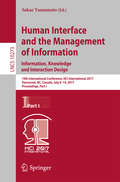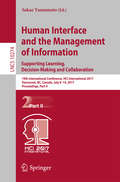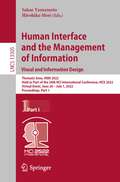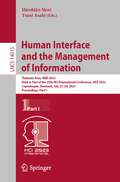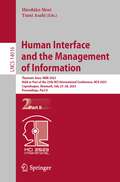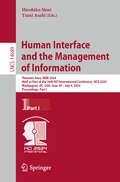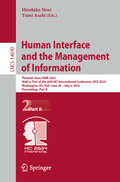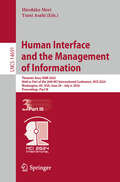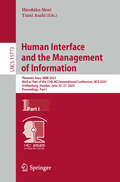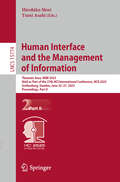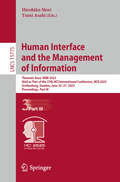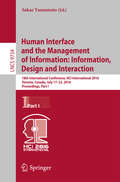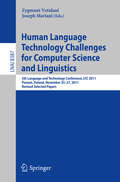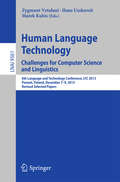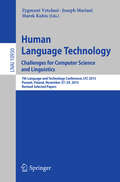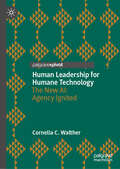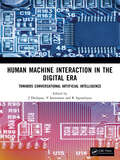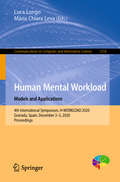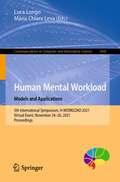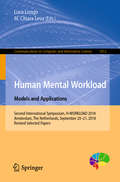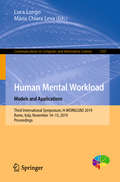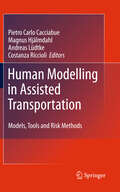- Table View
- List View
Human Interface and the Management of Information: Information, Knowledge and Interaction Design
by Sakae YamamotoThe two-volume set LNCS 10273 and 10274 constitutes the refereed proceedings of the thematic track on Human Interface and the Management of Information, held as part of the 19th HCI International 2017, in Vancouver, BC, Canada, in July 2017. HCII 2017 received a total of 4340 submissions, of which 1228 papers were accepted for publication after a careful reviewing process. The 102 papers presented in these volumes were organized in topical sections as follows: Part I: Visualization Methods and Tools; Information and Interaction Design; Knowledge and Service Management; Multimodal and Embodied Interaction. Part II: Information and Learning; Information in Virtual and Augmented Reality; Recommender and Decision Support Systems; Intelligent Systems; Supporting Collaboration and User Communities; Case Studies.
Human Interface and the Management of Information: Supporting Learning, Decision-Making and Collaboration
by Sakae YamamotoThe two-volume set LNCS 10273 and 10274 constitutes the refereed proceedings of the thematic track on Human Interface and the Management of Information, held as part of the 19th HCI International 2017, in Vancouver, BC, Canada, in July 2017. HCII 2017 received a total of 4340 submissions, of which 1228 papers were accepted for publication after a careful reviewing process. The 102 papers presented in these volumes were organized in topical sections as follows: Part I: Visualization Methods and Tools; Information and Interaction Design; Knowledge and Service Management; Multimodal and Embodied Interaction. Part II: Information and Learning; Information in Virtual and Augmented Reality; Recommender and Decision Support Systems; Intelligent Systems; Supporting Collaboration and User Communities; Case Studies.
Human Interface and the Management of Information: Thematic Area, HIMI 2022, Held as Part of the 24th HCI International Conference, HCII 2022, Virtual Event, June 26 – July 1, 2022, Proceedings, Part I (Lecture Notes in Computer Science #13305)
by Sakae Yamamoto Hirohiko MoriThis two-volume set LNCS 13305 - 13306 constitutes the thoroughly refereed proceedings of the thematic area Human Interface and the Management of Information, HIMI 2022, which was held as part of HCI International 2022 and took place virtually during June 26-July 1, 2022.The total of 1271 papers and 275 poster papers included in the 39 HCII 2022 proceedings volumes was carefully reviewed and selected from 5487 submissions. The papers included in the HCII-HIMI volume set were organized in topical sections as follows: Part I: Human-centered design approaches; information design and quality; visual design; visualization and big data; Information, cognition and learning. Part II: Recommender systems; robots and avatars appearance and embodiment; information in virtual and augmented reality; information in complex technological environments.
Human Interface and the Management of Information: Thematic Area, HIMI 2023, Held as Part of the 25th HCI International Conference, HCII 2023, Copenhagen, Denmark, July 23–28, 2023, Proceedings, Part I (Lecture Notes in Computer Science #14015)
by Hirohiko Mori Yumi AsahiThis two-volume set LNCS 14015 - 14016 constitutes the thoroughly refereed proceedings of the thematic area Human Interface and the Management of Information, HIMI 2023, which was held as part of HCI International 2023 which took place in Copenhagen, Denmark, during July 23-28, 2023.A total of 1578 papers and 396 posters have been accepted for publication in the HCII 2023 proceedings from a total of 7472 submissions. The papers included in the HCII-HIMI volume set were organized in topical sections as follows: Part I: Information design and user experience; data visualization and big data; multimodal interaction; interacting with AI and intelligent systems; Part II: Service design; knowledge in eLearning and eEducation; supporting work and collaboration.
Human Interface and the Management of Information: Thematic Area, HIMI 2023, Held as Part of the 25th HCI International Conference, HCII 2023, Copenhagen, Denmark, July 23–28, 2023, Proceedings, Part II (Lecture Notes in Computer Science #14016)
by Hirohiko Mori Yumi AsahiThis two-volume set LNCS 14015 - 14016 constitutes the thoroughly refereed proceedings of the thematic area Human Interface and the Management of Information, HIMI 2023, which was held as part of HCI International 2023 which took place in Copenhagen, Denmark, during July 23-28, 2023.A total of 1578 papers and 396 posters have been accepted for publication in the HCII 2023 proceedings from a total of 7472 submissions. The papers included in the HCII-HIMI volume set were organized in topical sections as follows: Part I: Information design and user experience; data visualization and big data; multimodal interaction; interacting with AI and intelligent systems; Part II: Service design; knowledge in eLearning and eEducation; supporting work and collaboration.
Human Interface and the Management of Information: Thematic Area, HIMI 2024, Held as Part of the 26th HCI International Conference, HCII 2024, Washington, DC, USA, June 29–July 4, 2024, Proceedings, Part I (Lecture Notes in Computer Science #14689)
by Hirohiko Mori Yumi AsahiThis three-volume set LNCS 14789-14791 constitutes the thoroughly refereed proceedings of the thematic area Human Interface and the Management of Information, HIMI 2024, held as part of the 26th International Conference on Human-Computer Interaction, HCI International 2024 (HCII 2024), was held as a hybrid event in Washington DC, USA, during June/July 2024. The total of 1271 papers and 309 posters included in the HCII 2023 proceedings was carefully reviewed and selected from 5108 submissions. The HIMI conference addressed approaches and objectives of information and data design, retrieval, presentation and visualization, management, and evaluation in human computer interaction in a variety of application domains, such as, for example, learning, work, decision, collaboration, medical support, and service engineering, and much more.
Human Interface and the Management of Information: Thematic Area, HIMI 2024, Held as Part of the 26th HCI International Conference, HCII 2024, Washington, DC, USA, June 29–July 4, 2024, Proceedings, Part II (Lecture Notes in Computer Science #14690)
by Hirohiko Mori Yumi AsahiThis three-volume set LNCS 14789-14791 constitutes the thoroughly refereed proceedings of the thematic area Human Interface and the Management of Information, HIMI 2024, held as part of the 26th International Conference on Human-Computer Interaction, HCI International 2024 (HCII 2024), was held as a hybrid event in Washington DC, USA, during June/July 2024. The total of 1271 papers and 309 posters included in the HCII 2023 proceedings was carefully reviewed and selected from 5108 submissions. The HIMI conference addressed approaches and objectives of information and data design, retrieval, presentation and visualization, management, and evaluation in human computer interaction in a variety of application domains, such as, for example, learning, work, decision, collaboration, medical support, and service engineering, and much more.
Human Interface and the Management of Information: Thematic Area, HIMI 2024, Held as Part of the 26th HCI International Conference, HCII 2024, Washington, DC, USA, June 29–July 4, 2024, Proceedings, Part III (Lecture Notes in Computer Science #14691)
by Hirohiko Mori Yumi AsahiThis three-volume set LNCS 14789-14791 constitutes the thoroughly refereed proceedings of the thematic area Human Interface and the Management of Information, HIMI 2024, held as part of the 26th International Conference on Human-Computer Interaction, HCI International 2024 (HCII 2024), was held as a hybrid event in Washington DC, USA, during June/July 2024. The total of 1271 papers and 309 posters included in the HCII 2023 proceedings was carefully reviewed and selected from 5108 submissions. The HIMI conference addressed approaches and objectives of information and data design, retrieval, presentation and visualization, management, and evaluation in human computer interaction in a variety of application domains, such as, for example, learning, work, decision, collaboration, medical support, and service engineering, and much more.
Human Interface and the Management of Information: Thematic Area, HIMI 2025, Held as Part of the 27th HCI International Conference, HCII 2025, Gothenburg, Sweden, June 22–27, 2025, Proceedings, Part I (Lecture Notes in Computer Science #15773)
by Hirohiko Mori Yumi AsahiThe three-volume set LNCS 15773 - 15775 constitutes the thoroughly refereed proceedings of the thematic area Human Interface and the Management of Information, HIMI 2025, held as part of the 27th International Conference on Human-Computer Interaction, HCI International 2025 (HCII 2025), which was held in Gothenburg, Sweden, during June 22–27, 2025. The total of 1430 papers and 355 posters included in the HCII 2025 proceedings was carefully reviewed and selected from 7972 submissions. The papers in these proceedings have been organized in topical sections as follows: Part I: Information design and visualization; human-human and human-AI collaboration; user experience design and evaluation; Part II: Information in eHealth; information, knowledge and learning; Part III: Multimodality and information; eCommerce and industrial applications.
Human Interface and the Management of Information: Thematic Area, HIMI 2025, Held as Part of the 27th HCI International Conference, HCII 2025, Gothenburg, Sweden, June 22–27, 2025, Proceedings, Part II (Lecture Notes in Computer Science #15774)
by Hirohiko Mori Yumi AsahiThe three-volume set LNCS 15773 - 15775 constitutes the thoroughly refereed proceedings of the thematic area Human Interface and the Management of Information, HIMI 2025, held as part of the 27th International Conference on Human-Computer Interaction, HCI International 2025 (HCII 2025), which was held in Gothenburg, Sweden, during June 22–27, 2025. The total of 1430 papers and 355 posters included in the HCII 2025 proceedings was carefully reviewed and selected from 7972 submissions. The papers in these proceedings have been organized in topical sections as follows: Part I: Information design and visualization; human-human and human-AI collaboration; user experience design and evaluation; Part II: Information in eHealth; information, knowledge and learning; Part III: Multimodality and information; eCommerce and industrial applications.
Human Interface and the Management of Information: Thematic Area, HIMI 2025, Held as Part of the 27th HCI International Conference, HCII 2025, Gothenburg, Sweden, June 22–27, 2025, Proceedings, Part III (Lecture Notes in Computer Science #15775)
by Hirohiko Mori Yumi AsahiThe three-volume set LNCS 15773 - 15775 constitutes the thoroughly refereed proceedings of the thematic area Human Interface and the Management of Information, HIMI 2025, held as part of the 27th International Conference on Human-Computer Interaction, HCI International 2025 (HCII 2025), which was held in Gothenburg, Sweden, during June 22–27, 2025. The total of 1430 papers and 355 posters included in the HCII 2025 proceedings was carefully reviewed and selected from 7972 submissions. The papers in these proceedings have been organized in topical sections as follows: Part I: Information design and visualization; human-human and human-AI collaboration; user experience design and evaluation; Part II: Information in eHealth; information, knowledge and learning; Part III: Multimodality and information; eCommerce and industrial applications.
Human Interface and the Management of Information:Information, Design and Interaction
by Sakae YamamotoThe three-volume set LNCS 8016, 8017, and 8018 constitutes the refereed proceedings of the 15th International Conference on Human-Computer Interaction, HCII 2013, held in Las Vegas, NV, USA in July 2013. The total of 1666 papers and 303 posters presented at the HCII 2013 conferences was carefully reviewed and selected from 5210 submissions. These papers address the latest research and development efforts and highlight the human aspects of design and use of computing systems. The papers accepted for presentation thoroughly cover the entire field of human-computer Interaction, addressing major advances in knowledge and effective use of computers in a variety of application areas. This volume contains papers in the thematic area of human interface and the management of Information, addressing the following major topics: interacting with information, information searching, browsing and structuring, design and development methods and tools for interactive systems and services, personalized information and interaction, cognitive and emotional aspects of interacting with information.
Human Language Technology Challenges for Computer Science and Linguistics
by Joseph Mariani Zygmunt VetulaniThis book constitutes the refereed proceedings of the 5th Language and Technology Conference: Challenges for Computer Science and Linguistics, LTC 2011, held in Poznan, Poland, in November 2011. The 44 revised and in many cases substantially extended papers presented in this volume were carefully reviewed and selected from 111 submissions. The focus of the papers is on the following topics: speech, parsing, computational semantics, text analysis, text annotation, language resources: general issues, language resources: ontologies and Wordnets and machine translation.
Human Language Technology Challenges for Computer Science and Linguistics: 5th Language and Technology Conference, LTC 2011, Poznań, Poland, November 25--27, 2011, Revised Selected Papers (Lecture Notes in Computer Science #8387)
by Zygmunt Vetulani and Joseph MarianiThis book constitutes the refereed proceedings of the 5th Language and Technology Conference: Challenges for Computer Science and Linguistics, LTC 2011, held in Poznan, Poland, in November 2011. The 44 revised and in many cases substantially extended papers presented in this volume were carefully reviewed and selected from 111 submissions. The focus of the papers is on the following topics: speech, parsing, computational semantics, text analysis, text annotation, language resources: general issues, language resources: ontologies and Wordnets and machine translation.
Human Language Technology. Challenges for Computer Science and Linguistics
by Zygmunt Vetulani Hans Uszkoreit Marek KubisThis book constitutes the refereed proceedings of the 5th Language and Technology Conference: Challenges for Computer Science and Linguistics, LTC 2011, held in Poznan, Poland, in November 2011. The 44 revised and in many cases substantially extended papers presented in this volume were carefully reviewed and selected from 111 submissions. The focus of the papers is on the following topics: speech, parsing, computational semantics, text analysis, text annotation, language resources: general issues, language resources: ontologies and Wordnets and machine translation.
Human Language Technology. Challenges for Computer Science and Linguistics: 7th Language and Technology Conference, LTC 2015, Poznań, Poland, November 27-29, 2015, Revised Selected Papers (Lecture Notes in Computer Science #10930)
by Joseph Mariani Zygmunt Vetulani Marek KubisThis book constitutes the refereed proceedings of the 7h Language and Technology Conference: Challenges for Computer Science and Linguistics, LTC 2015, held in Poznan, Poland, in November 2015. The 31 revised papers presented in this volume were carefully reviewed and selected from 108 submissions. The papers selected to this volume belong to various fields of: Speech Processing; Multiword Expressions; Parsing; Language Resources and Tools; Ontologies and Wordnets; Machine Translation; Information and Data Extraction; Text Engineering and Processing; Applications in Language Learning; Emotions, Decisions and Opinions; Less-Resourced Languages.
Human Language Technology. Challenges for Computer Science and Linguistics: 8th Language and Technology Conference, LTC 2017, Poznań, Poland, November 17–19, 2017, Revised Selected Papers (Lecture Notes in Computer Science #12598)
by Zygmunt Vetulani Marek Kubis Patrick ParoubekThis book constitutes the refereed proceedings of the 8th Language and Technology Conference: Challenges for Computer Science and Linguistics, LTC 2017, held in Poznan, Poland, in November 2017. The 26 revised papers presented in this volume were carefully reviewed and selected from 97 submissions. The papers selected to this volume belong to various fields of: Language Resources, Tools and Evaluation, Less-Resourced-Languages, Speech Processing, Morphology, Computational Semantics, Machine Translation, and Information Retrieval and Information Extraction.
Human Language Technology. Challenges for Computer Science and Linguistics: 9th Language and Technology Conference, LTC 2019, Poznan, Poland, May 17–19, 2019, Revised Selected Papers (Lecture Notes in Computer Science #13212)
by Zygmunt Vetulani Marek Kubis Patrick ParoubekThis book constitutes the refereed proceedings of the 9th Language and Technology Conference: Challenges for Computer Science and Linguistics, LTC 2019, held in Poznan, Poland, in May 2019. The 24 revised papers presented in this volume were carefully reviewed and selected from 67 submissions. The papers are categorized into the following topical sub-headings: Speech Processing; Language Resources and Tools; Computational Semantics; Emotions, Decisions and Opinions; Digital Humanities; Evaluation; and Legal Aspects.
Human Leadership for Humane Technology: The New AI: Agency Ignited
by Cornelia C. WaltherThis book explores the relationship of natural and artificial intelligence in our rapidly evolving world. It does so anchored in an innovative multidisciplinary framework and the premise that society is a composition of multiple dimensions, with individuals (micro), communities (meso), countries (macro) and planet (meta) in the collective sphere, and individuals themselves as multidimensional beings (aspirations, emotions, thoughts, sensations). This perspective is applied to analyze the implications of our transition into a phase where online and offline realms are increasingly intertwined. Special attention is given to the influence of all pervasive technology on our perception of the self and society. The central message is that we must learn to harness Agency amid AI, which entails double literacy – of artificial and natural intelligence.
Human Machine Interaction in the Digital Era: Towards Conversational Artificial Intelligence
by J. Dhilipan V. Saravanan R. AgusthiyarThe Human Machine Interaction in the Digital Era (ICHMIDE) 2023 conference aims to address the main issues of concern in the design issues with a particular emphasis on the design and development of interfaces for autonomous robots. Its main objective is to provide an international forum for the dissemination and exchange of up-to-date scientific information on research related to integrated human/machine systems at multiple scales, and includes areas such as human/machine interaction, engineering mathematical models, assistive technologies, system modelling, design, testing and validation. The organization of ICHMS is based on the following Track types: Smart Applications for Digital Era, Computational Mathematical and Electronics, Intelligent Systems in Security and Communication Technologies, Technological Interventions using AI and Machine Learning, Applied Science, and IoT Techniques for Industries.
Human Mental Workload: 4th International Symposium, H-WORKLOAD 2020, Granada, Spain, December 3–5, 2020, Proceedings (Communications in Computer and Information Science #1318)
by Luca Longo Maria Chiara LevaThis book constitutes the refereed proceedings of the 4th International Symposium on Human Mental Workload: Models and Applications, H-WORKLOAD 2020, held in Granda, Spain*, in December 2020.The volume presents one keynote paper as well as 13 revised full papers, which were carefully reviewed and selected from 22 submissions. The papers are organized in two topical sections on models and applications.*The conference was held virtually due to the COVID-19 pandemic.
Human Mental Workload: 5th International Symposium, H-WORKLOAD 2021, Virtual Event, November 24–26, 2021, Proceedings (Communications in Computer and Information Science #1493)
by Luca Longo Maria Chiara LevaThis book constitutes the refereed proceedings of the 5th International Symposium on Human Mental Workload: Models and Applications, H-WORKLOAD 2021, held virtually in November 2021.The volume presents 9 revised full papers, which were carefully reviewed and selected from 16 submissions. The papers are organized in two topical sections on models and applications.
Human Mental Workload: Second International Symposium, H-WORKLOAD 2018, Amsterdam, The Netherlands, September 20-21, 2018, Revised Selected Papers (Communications in Computer and Information Science #1012)
by Luca Longo M. Chiara LevaThis book constitutes the refereed proceedings of the Second International Symposium on Human Mental Workload: Models and Applications, H-WORKLOAD 2018, held in Amsterdam, The Netherlands, in September 2018. The 15 revised full papers presented together with one keynote were carefully reviewed and selected from 31 submissions. The papers are organized in two topical sections on models and applications.
Human Mental Workload: Third International Symposium, H-WORKLOAD 2019, Rome, Italy, November 14–15, 2019, Proceedings (Communications in Computer and Information Science #1107)
by Luca Longo Maria Chiara LevaThis book constitutes the refereed proceedings of the Third International Symposium on Human Mental Workload: Models and Applications, H-WORKLOAD 2019, held in Rome, Italy, in November 2019.The volume presents one keynote paper as well as 14 revised full papers, which were carefully reviewed and selected from 32 submissions. The papers are organized in two topical sections on models and applications.
Human Modelling in Assisted Transportation
by Carlo Cacciabue Magnus Hjälmdahl Costanza Riccioli Andreas LuedtkeThe objective of this Workshop is to confront models, methods and tools developed within the projects with the ongoing research worldwide and to provide an environment for fruitful exchange of ideas. The main topics are: 1. Advanced human models in transportation. 2. Human Errors and Risk Assessment in design processes of assistance systems. 3. Methods and tools to prevent erroneous behaviour to mitigate its consequences. The Workshop will consist of 10 keynote lectures as well as approximately 28 peer reviewed papers.
